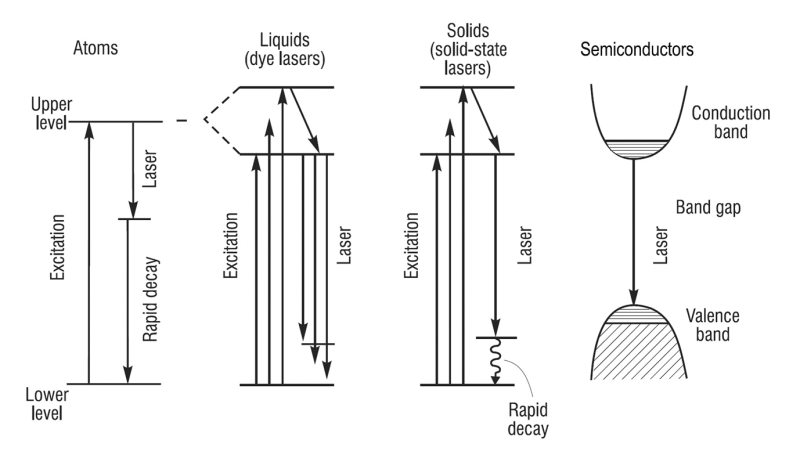What are the 3 types of lasers?
Summary of the Article: Types and Uses of Lasers
Lasers are widely used in various fields and applications. There are three main types of lasers: gas, liquid, and solid-state lasers. Each type has its own unique properties and uses. Class 3B lasers, which are medium-power lasers, require control measures to prevent eye exposure. The most powerful type of laser is the Zetawatt-Equivalent Ultrashort pulse laser System (ZEUS) that produces an ultra-short, extremely powerful pulse. There are four main classes of lasers: Class 2, Class 3R, Class 3B, and Class 4. CO2 lasers are the most commonly used type of laser, mainly for laser marking, cutting, and welding. Class 4 lasers can burn skin and materials and are hazardous to pilots and drivers. Laser therapy using Class 4 lasers can be used to reduce pain and inflammation. Green lasers are the most powerful and visible in daylight. It is legal to own lasers of any power and class as long as they are FDA compliant.
Questions and Answers
- What are 3 main types of lasers?
Gas, liquid, and solid-state lasers are the three main types of lasers. - What are Class 3 lasers used for?
Class 3B lasers are used for spectrometry, stereolithography, and entertainment light shows. However, direct viewing of the Class 3B laser beam can be hazardous to the eye. - What is a Class 3 laser?
Class 3 lasers are medium-power lasers that require control measures to prevent viewing of the direct beam. These lasers pose a risk to the eyes if exposed to the primary or specularly reflected beam. - What’s the most powerful type of laser?
The Zetawatt-Equivalent Ultrashort pulse laser System (ZEUS) is the most powerful type of laser, producing an ultra-short, extremely powerful pulse. - What are the 4 classes of lasers?
The four main classes of visible-beam lasers are Class 2, Class 3R, Class 3B, and Class 4. Class 2 and Class 3R are relatively safe for eye exposure, while Class 3B and Class 4 are hazardous. - What is the most commonly used laser type?
CO2 lasers are widely used for laser marking, cutting, and welding, making them the most commonly used type of laser. - Can a Class 4 laser burn?
Yes, a Class 4 laser can burn skin and materials, especially dark and/or lightweight materials at close range. It can also pose hazards for pilots and drivers. - What is Class 4 laser used for?
Class 4 lasers, such as MLS Class 4 laser therapy, are used for managing chronic and acute pain, reducing inflammation in musculoskeletal disorders, and treating joint pain. - What color laser is most powerful?
Green lasers are the most powerful and visible, even in areas of broad daylight and direct sunlight. They are commonly used on construction sites due to their efficiency and long-distance visibility. - What is the strongest laser you can legally own?
It is completely legal to own lasers of any power and class as long as they are FDA compliant. However, laser products with a power greater than 5 mW cannot be marketed as “laser pointers” or for pointing purposes. - What is a Class 5 laser?
Class 5 Photonics provides high-power laser systems and EUV sources for various applications, including bio-imaging, ultrafast science, and attosecond science. - Can a Class 3 laser burn?
Class 3B lasers can heat skin and materials but are not considered a burn hazard. For visible-light lasers, the output power of a Class 3B laser falls between 5 and 499 milliwatts.

What are 3 main types of lasers
Types of LasersGas.Liquid.Semiconductor.Solid-State.Fiber.
What are Class 3 lasers used for
Some examples of Class 3B laser uses are spectrometry, stereolithography, and entertainment light shows. Direct viewing of the Class 3B laser beam is hazardous to the eye and diffuse reflections of the beam can also be hazardous to the eye.
What is class 3 laser
Class 3 lasers are medium power lasers or laser systems that require control measures to prevent viewing of the direct beam. Control measures emphasize preventing exposure of the eye to the primary or specularly reflected beam.
What’s the most powerful type of laser
Known as the Zetawatt-Equivalent Ultrashort pulse laser System (ZEUS), it produces an ultra-short, extremely powerful pulse of just 25 femtoseconds. A femtosecond is a quadrillionth of a second – or to put it another way, a femtosecond is to a second what a second is to about 31.71 million years.
What are the 4 classes of lasers
There are four main classes for visible-beam lasers: Class 2, Class 3R, Class 3B and Class 4. The first two are relatively safe for eye exposure; the last two are hazardous.
What is the most commonly used laser type
CO2 lasers are probably the most widely known gas lasers and are mainly used for laser marking, laser cutting, and laser welding.
Can a Class 4 laser burn
A Class 4 laser can burn skin and materials, especially dark and/or lightweight materials at close range. A Class 4 laser can be a distraction, glare or flashblindness hazard for pilots and drivers. It may also be a potential eye injury hazard for pilots at relatively close range.
What is Class 4 laser used for
Laser therapy provides a non-drug alternative for the management of chronic and acute pain. MLS Class 4 laser therapy can be used to reduce pain and inflammation in musculoskeletal disorders and injuries and joint pain.
What Colour laser is most powerful
Did you know that a green laser light is ten to 50 times brighter than a red light laser Green lasers are much more efficient and visible in areas of broad daylight and direct sunlight. They are also able to travel longer distances, which is why they are so popular on construction sites.
What is the strongest laser you can legally own
In short, it's completely legal to own lasers of any power and any class as long as they're FDA compliant in the US. However, it's illegal to sell laser products with a power greater than 5 mW while being branded as “laser pointer” or marketed for pointing purposes.
What is a Class 5 laser
Class 5 Photonics provides ultrafast, high-power laser systems and EUV sources for demanding applications from bio-imaging to ultrafast science and attosecond science.
Can a Class 3 laser burn
Class 3B lasers – Intrinsically hazardous to the eye. They can heat skin and materials but are not considered a burn hazard. For visible-light lasers, Class 3B laser output power is between 5 and 499 milliwatts.
What laser is easiest to see
green
Not only is green the easiest color to see, it's easier to see over a distance, which is important when using a laser level.
What is the safest class of laser
Class 1 laser
A Class 1 laser is considered safe based upon current medical knowledge. This class includes all lasers or laser systems which cannot emit levels of optical radiation above the exposure limits for the eye under any exposure conditions inherent in the design of the laser product.
Are Class 4 lasers illegal in US
Consumers should be aware that: – Medical lasers may only be sold to licensed medical practitioners. – Class IIIb and class IV laser light show projectors, identified as such on the label, may only be sold by or to individuals or firms with current, approved laser light show variances from FDA.
What are Class 5 lasers
Class 5 Photonics provides ultrafast, high-power laser systems and EUV sources for demanding applications from bio-imaging to ultrafast science and attosecond science.
What color laser does most damage
In general, green and red lasers have the least potential to do harm because the human eye is sensitive to these colors and will react fairly quickly. Blue and violet lasers have a fairly high potential for harm because our eyes are less sensitive to these colors.
Does the military use red or green lasers
The short answer is, Yes. Visible colors like green, red, blue, and even purple/violet are used. The most common of the visible colors used would be Green and Red for a few key reasons.
What wattage laser is illegal
Under federal law, it is perfectly legal to sell any laser above 5 mW as long as the laser complies with FDA/CDRH laser product requirements for labels, safety features, quality control, etc. AND as long as the laser is not promoted as a “laser pointer” or for pointing purposes.
Why are full power lasers illegal
Because IR lasers are invisible to naked eyes, there is no reflexive response to look away or shut them. This means exposure can take place without the victim even knowing it, causing serious damage or permanent blindness. So, it is clear why the sale of these devices is restricted.
Are Class 4 lasers the most hazardous laser
Class 4 is the highest class in terms of laser hazards. If you're within the hazard zone, you're exposed to severe eye and skin injuries. In addition, combustible materials shouldn't be in the laser's surroundings to avoid fire hazards. Diffuse reflections of class 4 lasers are also hazardous.
What can a Class 4 laser do
A Class 4 laser can burn skin and materials, especially dark and/or lightweight materials at close range. A Class 4 laser can be a distraction, glare or flashblindness hazard for pilots and drivers. It may also be a potential eye injury hazard for pilots at relatively close range.
Are Class 4 lasers safe
Class 4 is the highest class in terms of laser hazards. If you're within the hazard zone, you're exposed to severe eye and skin injuries. In addition, combustible materials shouldn't be in the laser's surroundings to avoid fire hazards. Diffuse reflections of class 4 lasers are also hazardous.
Which color laser is most powerful
Did you know that a green laser light is ten to 50 times brighter than a red light laser Green lasers are much more efficient and visible in areas of broad daylight and direct sunlight. They are also able to travel longer distances, which is why they are so popular on construction sites.
What laser is invisible to the eye
infrared laser
Unlike the laser pointers used in lecture halls or as toys, the powerful infrared laser the scientists worked with emits light waves thought to be invisible to the human eye.



